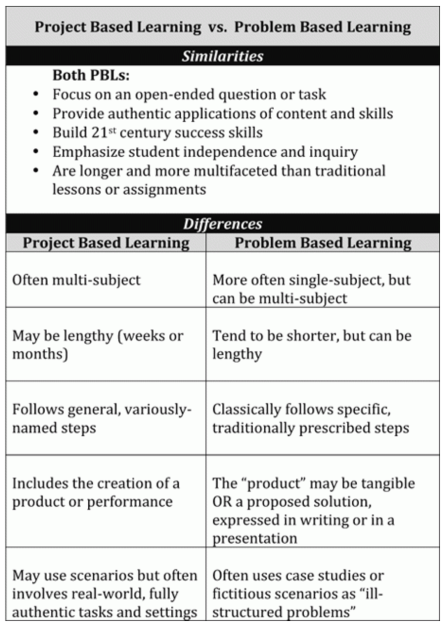 Many educators I’ve met have mentioned project-based learning or problem-based learning at least once. However, these terms aren’t interchangeable and the focus of each strategy is somewhat different.
Many educators I’ve met have mentioned project-based learning or problem-based learning at least once. However, these terms aren’t interchangeable and the focus of each strategy is somewhat different.
Project-based learning dates back to the early twentieth century whereas Problem-based learning was developed about forty years later; the former is centered around investigating a complex problem that can involve more than one subject, while the latter is subject-focused and involves a more narrow approach.
Campbell describes the disciplines as: “Project-based learning is often multidisciplinary and longer, whereas problem based learning is more likely to be a single subject and shorter. Generally, project-based learning follows general steps while problem-based learning provides specific steps” (2014).
Larmer provides an excellent graphic that compares and contrasts the two:

When investigating the efficacy of PBL Dochy et. al. wrote:
“The claims of PBL advocates are not all supported by an extensive research base, and much of the research has been restricted to higher education, predominantly in medical schools. There is little research with K- 12 populations … It would be naïve to believe that the medical school model of PBL could be imported into other settings without considering how to adapt it to the local context, goals, and developmental level of learners. Another barrier to using PBL in K-12 education is the constraints of classroom organization. The model of PBL in medical school involves an integrated, interdisciplinary curriculum organized around problems rather than subject domains. In most K-12 situations, teachers must assess students in specific subject areas and problems often do not map neatly onto these subject area divisions. Moreover, it requires careful planning to engage in PBL in 50-min class periods” (2003).
Meta-analyses have yet to prove that Problem-based learning is effective outside of carefully constructed scenarios (Hattie, 2008). However, this doesn’t mean that elementary teachers could not benefit from units of instruction that involve Problem-based learning, rather careful planning is required to ensure learning is happening. Classrooms that are struggling academically may not benefit from this strategy in a way that justifies its implementation, but hopefully, future research will be able to pinpoint what aspects of problem-based learning make it beneficial to students.
Due to the similarities between Project- and Problem-based learning it would seem logical to conclude that neither have shown to correlate with high achievement gains in classrooms. Hopefully this does not encourage teachers to do away with either instructional method, but to carefully consider why and when to use them.
Works Cited
Campbell, C. (2014, September 16). Australian Council for Educational Research. Retrieved April 2017, from Teacher Magazine: https://www.teachermagazine.com.au/article/problem-based-learning-and-project-based-learning Dochy, F., SEgers, M., Bossche, P. V., & Gijbels, D. (2003). Effects of problem-based learning: a meta-anlysis. Learning and Instruction, 13. Hattie, J. (2008). Visible Learning: A Synthesis of Over 800 Meta-Analyses Relating to Achievement (1 ed.). Routledge. Hmelo-Silver, C. E. (2004). Problem-Based Learning: What and How Do Students Learn? Educational Psychology Review, 16(3), 235-266. Larmer, J. (2015, July). Project-Based Learning vs. Problem-Based Learning vs. X-BL. Retrieved April 2017, from Edutopia: https://www.edutopia.org/blog/pbl-vs-pbl-vs-xbl-john-larmer Partnership for 21st Century Learning. (n.d.). Framework for 21st Century Learning. Retrieved April 2017, from P21: http://www.p21.org/our-work/p21-framework Schmidt, H. G., Rotgans, J. I., & Yew, E. H. (2011). The process of problem-based learning: waht works and why. Medical Education, 45, 792-806.

 Hello again,
Hello again, Happy spring everyone!
Happy spring everyone! Hello again,
Hello again,